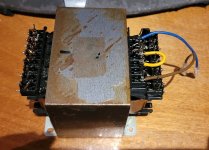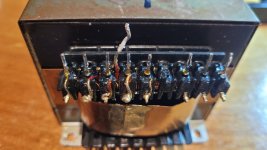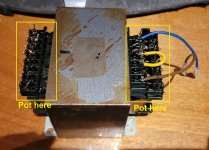G'day Guys.
I am considering potting a pair of power transformers.
They are salvaged from Pioneer multichannel home theatre amps.

I have modified the main secondary to split the centre tap into dual secondaries to suit my power supply design.

Once I attach some fresh lead wires, I would like to seal everything up nice and tight such that things can't move, short, vibrate, corrode etc.
Now come the questions:
1) If I was to encase the whole transformer in epoxy. Is there an advantage to using a steel box for additional magnetic shielding over say aluminium or plastic?
2) If using a metal box, should the transformer frame be connected to the box for grounding or should it be electrically floating?
3) If the whole transformer is potted, what would be the derating to be applied, 20%?
4) Are there any disadvantages to potting the whole transformer other than power derating and the inability to fix things in case of a fault?
5) Would a good option be to simply masking tape things up and pot only the area where the wires terminate:

6) Is epoxy the best option? Would polyurethane resin be more suitable?
7) Am I over thinking this whole thing? Should I simply heatshrink everything up and be done with it?
I am considering potting a pair of power transformers.
They are salvaged from Pioneer multichannel home theatre amps.

I have modified the main secondary to split the centre tap into dual secondaries to suit my power supply design.

Once I attach some fresh lead wires, I would like to seal everything up nice and tight such that things can't move, short, vibrate, corrode etc.
Now come the questions:
1) If I was to encase the whole transformer in epoxy. Is there an advantage to using a steel box for additional magnetic shielding over say aluminium or plastic?
2) If using a metal box, should the transformer frame be connected to the box for grounding or should it be electrically floating?
3) If the whole transformer is potted, what would be the derating to be applied, 20%?
4) Are there any disadvantages to potting the whole transformer other than power derating and the inability to fix things in case of a fault?
5) Would a good option be to simply masking tape things up and pot only the area where the wires terminate:

6) Is epoxy the best option? Would polyurethane resin be more suitable?
7) Am I over thinking this whole thing? Should I simply heatshrink everything up and be done with it?
Yes.G'day Guys.
I am considering potting a pair of power transformers.
I have modified the main secondary to split the centre tap into dual secondaries to suit my power supply design.
Once I attach some fresh lead wires, I would like to seal everything up nice and tight such that things can't move, short, vibrate, corrode etc.
Now come the questions:
1) If I was to encase the whole transformer in epoxy. Is there an advantage to using a steel box for additional magnetic shielding over say aluminium or plastic?
Both need grounding.2) If using a metal box, should the transformer frame be connected to the box for grounding or should it be electrically floating?
Better each on its own do you decide where and how.
I would add a terminal to one of transformer screws, rivet another to steel case, and use a grounding wire for each, grounding to power supply ground point; typically main caos junction (if split supply), where also secondary center tap returns.
Personally I do not derate them, potting is a good heat conductor, at least better than air which is what you had before potting.3) If the whole transformer is potted, what would be the derating to be applied, 20%?
See above.4) Are there any disadvantages to potting the whole transformer other than power derating and the inability to fix things in case of a fault?
Yes, transformer can not be repaired ... which in many cases is not practical anyway.
FWIW I have often "rewound" US 120V Fender (guitar amp) polyester resin potted PTs to Argentine 220V by plain winding a new one.
It takes WAY less time and costs same as trying to recycle original one.
IF absolutely needed because EI core is some wild size (happens on some European or Japanese transformers) unavailable here, I must cook transformer in an oven until potting burns and crumbles so I can scratch it away with a dental pick, hammer lamination apart with a small hammer, etc.
A mess.
5) Would a good option be to simply masking tape things up and pot only the area where the wires terminate:
No, you need potting everywhere, down to the deepest crevices; otherwise it's useless.
Polyurethane is used a lot, because it costs 1/3rd of epoxy. Heat shrink only takes care of terminals, not buzzing and other problems.6) Is epoxy the best option? Would polyurethane resin be more suitable?
7) Am I over thinking this whole thing? Should I simply heatshrink everything up and be done with it?
- Home
- Design & Build
- Parts
- On epoxy potting an EI transformer